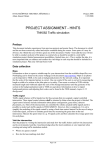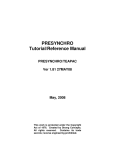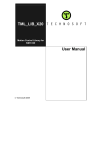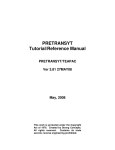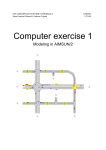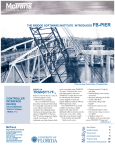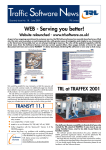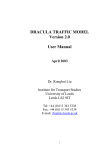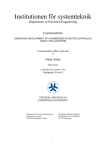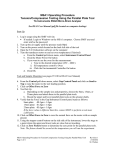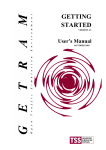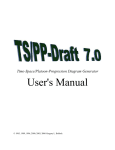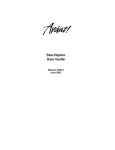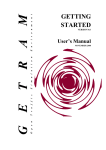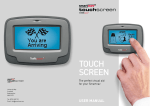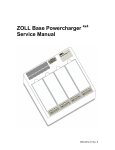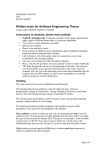Download Instructions
Transcript
LINKÖPINGS TEKNISKA HÖGSKOLA ITN/Johan Janson Olstam TNK062 Traffic modeling Traffic signals 2007 2007-11-23 Computer exercise with Capcal 1 Introduction This computer exercise is an introduction to the calculation program Capcal 3. Capcal (CAPacity CALculation) is a computer program for calculating effects of intersections and roundabouts. In this exercise you will practice calculations of non-signal intersection, signal intersections, and roundabouts. For some of the tasks will blueprints from VU-94 (Road design 94) be used, these blueprints is available in the appendix (but not in digital form). Except the guidance in this document there is also a program manual at c:\program\capcal3 (unfortunately only in Swedish) and a help function which can be accessed via the F1-button on the keyboard. The aim with this exercise is to increase your knowledge on different intersections types’ effects intersection performance. The aim is also to increase the understanding of how different traffic signal strategies work and which effect they have on an intersection. The examination in the traffic signal part in the course TNK062 Traffic modeling will include a small project with Capcal and the aim of this exercise is therefore also to give basic knowledge for running Capcal. In this document will menu and tab choices be written in bold style, for example: perform calculation (Calculation, Intersection). Input and calculation Start Capcal from the shortcut on the start menu and program\Capcal\. Input data to Capcal is prepared in the tabs Geometry/overview, Volumes, and Signal. There is also a tab for Report and Printout, see Figure 1. Figure 1 Screen picture from CAPCAL 2 The data that should feed into Capcal varies depending on intersection type and which calculation that should be performed. Non-signal intersections for example only demand data under the Geometry and Volumes tab while signal intersections also demand input data under the Signal tab. It is for each intersection type only possible to edit the data needed for the calculation of the specific intersection type. Calculation settings Capcal can be used to conduct different kinds of calculations. The type of calculation should be performed can be edited from the Calculations menu by marking or unmarking Cost Analysis and ADT-Calculation. We will not conduct any cost or ADT-calculations within this exercise, thus unmark the two alternatives (Calculations, Cost Analysis and Calculations, ADT-Calculation) Geometry input The appearance of the tab Geometry/overview varies depending on which intersection type that is chosen in the drop-down list up to the left. The tab has one appearance for stop, one for yield, one for signal, and one for roundabouts. Figure 2 shows the different data that can be edited for each approach. The allowed turnings are edited by clicking with the right mouse button on the picture that shows the allowed turnings. The gradient is the vertical incline of the current approach. Exit lane width Allowed turnings Shoulder width Refuge width Lane width Lane length Remove/Add the current intersection exit Figure 2 Geometry input to CAPCAL Number of lanes Remove/Add the current approach 3 Some of the input data is illustrated in Figure 3. Distance to stop line Angle Refuge width Radius Exit width Lane width Figure 3 Illustration of some of the geometric input data (Source: Capcal User manual) Figure 4 and Figure 5 illustrate some additional geometric input data for roundabouts. l = length of merging area b = width of merging area Figure 4 Illustration of some of the geometric input data (Source: Capcal User manual) 4 The width of the merging area is no longer used in Capcal. Instead the number of circulating lanes should be specified, i.e. number of lanes in the roundabout and not the number of lanes in the approaches. The length and the number of lanes in the roundabout are specified under the Header Roundabout, see screen-shot on next page. l Figure 5 Illustration of geometric input data for roundabouts in Capcal Traffic input Each approach and turn relation has to be assigned a traffic volume (vehicles/h). The proportion of trucks in percent is edited in the box besides the truck symbol. The bicycle edit box refer to the number of bicycles (cycles/h) driving among the vehicles in the lane, thus not bicycles on separate tracks. The pedestrian edit box refer to pedestrians and bicycles that cross the approach using an zebra-crossing, but only if the zebra crossing lies in connection with the intersection. 5 Intersection type A Create a new intersection (File, New). Choose yield regulation and set the speed limit both for the road and local to 50 km/h. Use geometric input data from blueprint A-3 gm (appendix 1), make reasonable assumptions for data that is missing. Change to the volumes tab and add traffic volumes according to Table 1. left A straight 340 right 120 left B straight right left 90 C straight 400 right left 45 D Straight right 70 Table 1 Vehicle volumes for exercises concerning intersection types A, B, and C. Heavy vehicle share 10%, and pedestrian and bicycle flow equal to 0. Save the intersection (File, Save). Conduct calculations (Calculation, Intersection) and view the results under the Report and Print tab 1 . It is possible to choose which input and output data that should be shown. Change regulation to stop instead of yield. Save the intersection with a new file name and redo the calculation. Compare the results, are there any differences? If so what is the reason? ___________________________________________________________________________ ___________________________________________________________________________ An alternative to start to prepare a Capcal intersection from scratch is to use one of the standard intersections available in the Capcal program directory under typkorsning. Choose a standard intersection similar to A-3gm and feed the model with traffic volumes. Calculate and compare the results with the earlier results. Is there any differences? (Why/why not?) ___________________________________________________________________________ ___________________________________________________________________________ Note: The results from Capcal depend on several variables. Some of them have a large impact on the result, for example the number of lanes while other has little impact, for example the lane width. Please experiment in order to find out which impact different variables have on the result. Test for example to increase the number of lanes and the lane width at some other approach. The two most used measures of quality-of-service are delay and degree of saturation. Increase the traffic flow successively and study how delay and degree of saturation changes, do the delay and degree of saturation have a positive or negative correlation? ___________________________________________________________________________ ___________________________________________________________________________ What happens when the degree of saturation gets close to 1? ___________________________________________________________________________ ___________________________________________________________________________ 1 The results are also saved in the file capout.xls which is available in c:\program\capcal3\. 6 Quality-of-service measurements The document VU-94 (http://www3.vv.se/vu94s2/) include a quality-of-service measurement based on the degree of saturation, see Table 2. The measure is defined per lane and refers to the lane with the highest degree of saturation. Intersection type ABCD E High standard <0,5 0,5-0,7 Moderate standard 0,5-0,7 0,3-0,5; 0,7-0,8 Low standard >0,7 <0,3; >0,8 Table 2 Quality-of-service measure based on degree of saturation according to VU-94. Grade the level of service for the A-3gm intersection – and henceforth – according to Table 2. How good is the quality-of-service?______________________________________________ ___________________________________________________________________________ Other quality-of-service measures are delay and queue lengths. Delay is probably the measure that most road users observe. Delay is also the measure that is easiest to express in monetary terms. Queue lengths are important for dimension of extra lanes in an intersection (vehicle store possibilities) and for controlling that the queues do not block intersections upstream. Intersection type B What is characteristic for intersection type B?______________________________________ ___________________________________________________________________________ Create a new intersection (File, New). Use blueprint B-3gm (appendix 1b) feed the model with the necessary geometric data. Choose yield regulation. Add traffic volumes according to Table 1. Save the intersection, conduct the calculation, and view the results. Are there any differences compared to intersection type A? Why/why not?____________________________________ ___________________________________________________________________________ ___________________________________________________________________________ How high is the level of service for this intersection?_________________________________ ___________________________________________________________________________ Intersection type C What is characteristic for intersection type C?______________________________________ ___________________________________________________________________________ 7 Create a new intersection. Use blueprint C-1g (appendix 2) and feed the model with the necessary geometric data. Choose yield regulation and add traffic volumes according to Table 1. Save the intersection, conduct the calculation, and view the results. Are there any differences compared to intersection type A? Why/why not?____________________________________ ___________________________________________________________________________ ___________________________________________________________________________ How high is the level of service for this intersection?_________________________________ ___________________________________________________________________________ Intersection type D What is characteristic for intersection type D?______________________________________ Choose any of the intersections model calculated above. Change regulation to roundabout. Redo the calculations and compare the results with the chosen intersection. What are the differences? _________________________________________________________________ ___________________________________________________________________________ ___________________________________________________________________________ Create a new intersection. Use blueprint D-4g (appendix 3) and feed the model with the necessary geometric data. The B-street have speed limit 50 km/h while the other streets have 70 km/h. Use traffic volumes from Table 3. left 230 A straight 790 right 160 left 30 B straight 140 right left 200 330 C straight 530 right 40 left 230 D Straight right 190 490 Table 3 Traffic volumes for a roundabout for the afternoon peek. Heavy vehicle share equal to 10 %, and a pedestrian flow of 230 pedestrians/h crossing the B-street. How high is the level of service for this intersection?_________________________________ How long is the total interaction delay?____________________________________________ Change the geometry of the intersection to only one incoming lane per approach. Redo the calculations and compare the results. What differences can be observed? ___________________________________________________________________________ ___________________________________________________________________________ 8 Intersection type E Terms Open the standard intersection Eovra4 (available from the Capcal program directory under typkorsning). View the signal phases and signal groups from the Signal tab. How many signal groups are there? ______________________________________________ How many phases are there?____________________________________________________ It is possible to edit the phases as one desire but with the restriction that primary conflicts is not allowed. There are also some other restrictions. Test to allow straight forward traffic in phase 2 by clicking on the arrow. Conduct a calculation, what happens? (Notice the information in the information field at the bottom of the Capcal window)________________ ___________________________________________________________________________ ___________________________________________________________________________ Thus, it is not possible to conduct a calculation when the phase configuration is conflicts with the rules for signal groups, which is the signal group rules?____________________________ ___________________________________________________________________________ ___________________________________________________________________________ Information about which conditions that is not fulfilled is given at the information field at the bottom of the program window. Edit the phase pictures to the original set up. Click with right mouse bottom on phase 2 and click on Edit in the pop-list that appears. It is now possible to edit the phase freely. It is now possible to allow right turnings from approach D, do so and then close the dialog box. The phase now becomes grey, which means that there exists a primary conflict. However if it in this case is possible (enough space etc) to turn left from C and right from D at the same time there is no conflict. Perform a calculation, what happens? _____________________________ ___________________________________________________________________________ Below follows an overview of some important traffic signal terms in Capcal Signal control Capcal calculates a fixed time signal, i.e. the signal is not affected by the traffic in real-time. The signal control should be changed to Signal group control when modeling modern adaptive traffic signal. Capcal then performs a correction of the results so that they better correspond to a modern traffic signal. Cycle time The cycle time can be set by the user (30-200s) or be set to be calculated by the program (40-120s). If Capcal is set to calculate the best cycle time, all values between 40 and 120 s with intervals of 5 s is tested. 9 Safety time The safety time cannot be handled at signal group level. The safe time must instead be set to the safe time that is dimensional for the phase. Min green The min green time should be set to 4 or 6 seconds for motor vehicles (normally 4 seconds at roads with speed limit 50 km/h and 6 seconds at roads with speed limit 70 km/h). Min green time for pedestrians must be set so that they are able to cross the road during the min green time. Max green The max green time should normally not be set. A value of 0 means that the max time is unrestricted. Start offset, End offset Start and end offset time can be used when more than one signal group have right of way in a phase in order to model that the signal groups have different start and/or end times. It is normally only the safe and min green time that needs to set. The calculations is not that exact that offset times has any large impact. Capcal is not recommended for calculations of coordinated traffic signals since it cannot handle the effects of the coordination. Capcal will give a higher delay than reasonable. For coordinated systems one should use programs like TRANSYT. Tasks Do calculations for example 1-3 from TV131 (see appendix 4-7). Please observe that there is both morning and afternoon traffic volumes available for example 3. Use the following safe times: 3 s (example 1), 4 s (example 2), and 5 s (example 3). Do not take the short lanes into considerations. The phase configurations is explained below and in illustrated in appendix 7. Example 1: Mixed phase (2-phase). Example 2: Phase 1 all turnings from west and east. Phase 2 all turnings from east. Phase 3 all turnings from north and south. Example 3: Phase 1 right and straight turnings from west and east. Phase 2 all turnings from north and south. Phase 3 left turnings from west and east. Phase 4 all turnings from west. Calculate the different intersections. Do the intersections work sati factionary? ___________________________________________________________________________ ___________________________________________________________________________ ___________________________________________________________________________ If the degree of saturation exceeds 0.7 for any of the intersections try to modify the intersections or the signal timing so that degree of saturation gets below 0.7. Which methods did you test and which of them worked? __________________________________________ ___________________________________________________________________________ ___________________________________________________________________________ Redo the calculations for example 1 and 2 but now with the length restrictions for the short lanes. Do the results change noticeable? ___________________________________________ ___________________________________________________________________________ 10 How to choose intersection type The Swedish road administration has developed a rough calculation method that can be used to give indications on which intersection type that is suitable, see Figure 6. Use the method to check which intersection type that is suitable for the 7 different intersections in Table 4. ´Choose Intersection type (god (good) = smaller intersection type, mindre god (moderate) = consider larger intersection type, black marked area = larger intersection type). Left 90 90 90 90 90 130 230 A Straig Right ht on 340 120 340 120 340 120 230 120 90 60 90 60 550 120 Left 70 150 40 75 75 130 70 B Straig Right ht on 65 40 65 40 65 150 65 40 65 40 65 40 65 40 Left 90 90 90 90 90 90 115 C Straig Right ht on 400 95 400 95 400 95 220 95 150 95 150 95 650 120 Left 45 150 70 65 65 65 45 D Straig Right ht on 30 70 30 70 30 150 30 70 30 70 30 70 30 70 Table 4 Traffic volumes for 7 different intersections. Figure 6 Rough calculation method for control of degree of saturation during the dimension hour for an urban intersection. (figur 7.5.2-2, VR50 för fyrvägskorsning ur VU-94) Calculate the degree of saturation with Capcal for one or more of the intersections. Grade the quality-of-service and compare it to the VU94 method, is the answer the same?______________________________________________________________________ 11 Calculations of Dalbyvägen in Lund Appendix 8 shows an overview of the south-east parts of the Swedish city Lund. There are four main intersections in the overview picture (Dalbyvägen/Tornavägen, Dalbyvägen/E22, Dalbyvägen/Porfyrvägen and Albyvägen/Sandbyvägen). Signal phase schemes are available in appendix 9-12, i.e. signal controllers 46, 912, 15 and 941. Traffic volumes are found in Table 5 to Table 7 (flows for Dalbyvägen/E22 is missing). Flow (vehicles/h) Morning Afternoon Today Forecast Today Forecast 34 49 52 73 303 423 656 918 8 11 28 39 345 483 736 1030 20 30 13 15 Approach W Turning Left Straight on Right Total Pedestrians N Left Straight on Right Total Pedestrians 205 110 18 333 143 281 162 22 465 189 317 99 32 448 196 444 139 45 628 223 E Left Straight on Right Total Pedestrians 258 513 393 1164 43 372 748 578 1698 57 201 460 175 836 45 281 644 245 1170 60 S Left Straight on Right Total Pedestrians 9 118 181 308 101 13 164 255 432 129 13 99 318 430 73 18 139 445 602 100 2150 3078 2450 3430 Total Table 5 Traffic volumes for Tornavägen/Dalbyvägen (peek hour). Heavy vehicle share 3 %. 12 Flow (vehicles/h) Morning Afternoon Today Forecast Today Forecast 167 225 102 147 446 599 1054 1520 571 767 317 458 1184 1591 1473 2125 Approach W Turning Left Straight on Right Total N Left Straight on Right Total 4 29 138 171 6 39 185 230 3 24 157 184 4 34 227 265 E Left Straight on Right Total 127 1136 2 1266 171 1527 3 1701 58 640 7 704 83 923 10 1016 S Left Straight on Right Total 224 28 31 283 301 38 42 381 451 24 143 617 650 34 206 890 2904 3903 2978 4296 Total Table 6 Traffic volumes for Porfyrvägen/Dalbyvägen (peek hour). Heavy vehicle share 3 %. 13 Flow (vehicles/h) Morning Afternoon Today Forecast Today Forecast 180 647 467 252 276 1001 733 386 50 22 18 70 506 1670 1218 708 Approach W Turning Left Straight on Right Total N Left Straight on Right Total 26 113 527 666 113 63 378 554 82 50 275 407 36 158 738 932 E Left Straight on Right Total 46 769 73 888 21 372 20 413 18 282 14 314 69 1035 102 1206 S Left Straight on Right Total 23 39 17 79 2139 101 136 113 350 2987 73 97 81 251 2190 32 55 24 111 2957 Total Table 7 Traffic volumes for Albyvägen/Sandbyvägen (peek hour). Heavy vehicle share 3 %.














